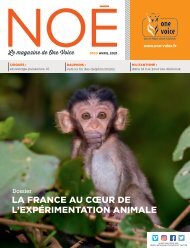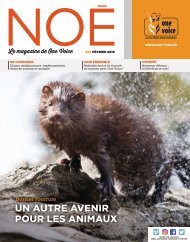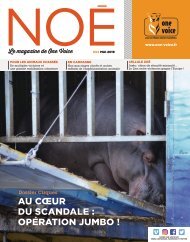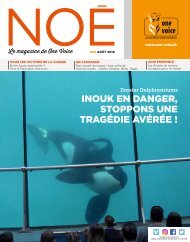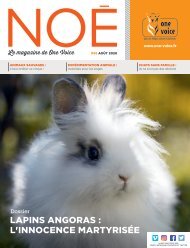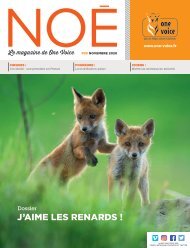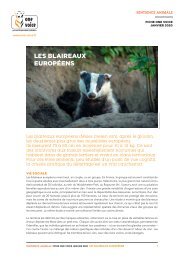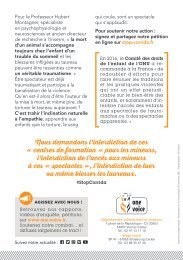The replacement of non human primates in brain research
Create successful ePaper yourself
Turn your PDF publications into a flip-book with our unique Google optimized e-Paper software.
3. <strong>The</strong> expression <strong>of</strong> at least 91 genes <strong>in</strong>volved <strong>in</strong> a variety <strong>of</strong> neural mechanisms differ between<br />
monkeys and <strong>human</strong>s. (12)<br />
4. As a <strong>research</strong>er on monkeys stated “ <strong>The</strong>re are “dramatic differences <strong>in</strong> the pattern <strong>of</strong><br />
convolutions” <strong>in</strong> the bra<strong>in</strong>s between monkeys and <strong>human</strong>s” (12)<br />
5. <strong>The</strong> visual areas differ <strong>in</strong> relative size between <strong>human</strong>s and monkeys. (12)<br />
6. While there are some visual areas <strong>in</strong> the monkey that correlate to those <strong>in</strong> <strong>human</strong>s <strong>in</strong> regards to<br />
location, there are many that do not. (12)<br />
Examples <strong>of</strong> experimental protocols on <strong>non</strong> <strong>human</strong> <strong>primates</strong><br />
<strong>in</strong>volv<strong>in</strong>g <strong>in</strong>vasive procedures - ethical and welfare issues<br />
Let us follow the fate <strong>of</strong> a monkey used <strong>in</strong> a laboratory experiment, to get an idea <strong>of</strong> what these<br />
animals endure.<br />
<strong>The</strong> follow<strong>in</strong>g excerpts from a recent statement by Nedim Buyukmihci, pr<strong>of</strong>essor <strong>of</strong> veter<strong>in</strong>ary<br />
medic<strong>in</strong>e at the University <strong>of</strong> Davis, California, accurately sum up the fate <strong>of</strong> these animals before<br />
they even reach the laboratory (13).<br />
“<strong>The</strong> capture <strong>of</strong> macaques from the wild unavoidably <strong>in</strong>flicts substantial suffer<strong>in</strong>g for the monkeys<br />
and is <strong>in</strong>herently cruel. Macaques are highly social animals whose sense <strong>of</strong> well-be<strong>in</strong>g and whose<br />
welfare are strongly and <strong>in</strong>extricably dependent on <strong>in</strong>tact family and similar social structure. Removal<br />
<strong>of</strong> <strong>in</strong>dividuals from the social group results <strong>in</strong> fractured families and social bonds. This causes<br />
extreme stress and distress for those taken as well as those left beh<strong>in</strong>d, the effects <strong>of</strong> which last<br />
<strong>in</strong>def<strong>in</strong>itely. It is not be<strong>in</strong>g anthropomorphic to state that the situation would be similar, <strong>in</strong> pr<strong>in</strong>ciple<br />
and <strong>in</strong> much <strong>of</strong> its effects, to similarly disrupt<strong>in</strong>g <strong>human</strong> families and social groups. In addition, it is<br />
common for monkeys to be <strong>in</strong>jured or killed dur<strong>in</strong>g trapp<strong>in</strong>g. It has been my experience that people<br />
do<strong>in</strong>g the trapp<strong>in</strong>g demonstrate little to no regard for the monkeys who are viewed either as<br />
unwanted “pests” or simply a source <strong>of</strong> <strong>in</strong>come.”<br />
Dr Buyukmihci cont<strong>in</strong>ues: “<strong>The</strong> normal relationship between mother and <strong>in</strong>fant is several years with<br />
respect to provid<strong>in</strong>g normal development. Removal prior to this time constitutes maternal, as well as<br />
social, deprivation.” This would mean that monkeys used <strong>in</strong> bra<strong>in</strong> <strong>research</strong> are developmentally<br />
challenged to beg<strong>in</strong> with.<br />
<strong>The</strong> next stage <strong>in</strong> the monkey’s ordeal will be transport from the hold<strong>in</strong>g or breed<strong>in</strong>g facility, to the<br />
actual laboratory. Long distance transportation <strong>in</strong>volves be<strong>in</strong>g packed s<strong>in</strong>gly <strong>in</strong> crates, before be<strong>in</strong>g<br />
shipped to countries half way around the globe. It is not uncommon for travel times to last up to 58<br />
hours (14) and for some <strong>of</strong> the animals to die before, dur<strong>in</strong>g, or after transportation to their<br />
dest<strong>in</strong>ation. Those that do survive this ordeal and reach the laboratory, or are actually bred <strong>in</strong> the<br />
country <strong>in</strong> which they will be used, then face an existence <strong>of</strong> <strong>in</strong>carceration <strong>in</strong> small steel cages, devoid<br />
<strong>of</strong> the environmental enrichment and rich social <strong>in</strong>teraction for which they have evolved.<br />
Macaques are extremely <strong>in</strong>telligent <strong>primates</strong> that naturally live <strong>in</strong> complex societies and form strong<br />
social bonds. Thus, it should be no great surprise that, <strong>in</strong> the isolated and unstimulat<strong>in</strong>g environment<br />
<strong>of</strong> the laboratory, macaques show signs <strong>of</strong> severe distress. Many macaques kept <strong>in</strong> standard<br />
laboratory cages exhibit stereotypical behaviour (15). <strong>The</strong>se can <strong>in</strong>clude more ‘moderate’ activities<br />
such as rock<strong>in</strong>g, head-twist<strong>in</strong>g and pac<strong>in</strong>g back and forth, to more extreme behaviours, <strong>in</strong>clud<strong>in</strong>g<br />
self-bit<strong>in</strong>g, eye-pok<strong>in</strong>g, body-throw<strong>in</strong>g and head-bang<strong>in</strong>g.<br />
10<br />
One Voice • <strong>The</strong> <strong>replacement</strong> <strong>of</strong> <strong>non</strong> <strong>human</strong> <strong>primates</strong> <strong>in</strong> bra<strong>in</strong> <strong>research</strong>



